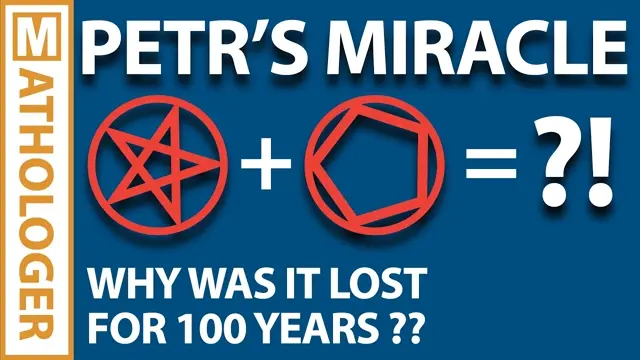2024-06-08
[public] 36.5K views, 7.22K likes, dislikes audio only
Today’s topic is the Petr-Douglas-Neumann theorem. John Harnad told me about this amazing result a couple of weeks ago and I pretty much decided on the spot that this would be the next Mathologer video. I really had a lot of fun bringing this one to life, maybe too much fun :)
Very good Wiki page on the Petr–Douglas–Neumann theorem https://en.wikipedia.org/wiki/Petr-Douglas-Neumann_theorem
Napoleon's theorem and the PDN theorem at Cut-the-knot https://www.cut-the-knot.org/ctk/Napolegon.shtml
Petr's original paper https://dml.cz/handle/10338.dmlcz/120936
Worth a look for eigenpolygon decomposition and other application within geometry, etc.
https://forumgeom.fau.edu/FG2015volume15/FG201527.pdf
https://forumgeom.fau.edu/FG2009volume9/FG200920.pdf
https://www.researchgate.net/publication/265706727_A_harmonic_analysis_of_polygons
A fantastic app that does the eigenpolygon decomposition contributed by Steven De Keninck from the Computer Vision Group at the University of Amsterdam
https://enki.ws/ganja.js/examples/coffeeshop.html#AONlCLF1r&fullscreen
Check out Branko Grünbaum notes on "Modern Elementary Geometry" https://tinyurl.com/5av8jwnk and G.C Shephard's "Sequences of smoothed polygons" (paywalled) for how all this fits in the grand scheme of things.
John Harnad's YouTube video on a complete proof of the Petr-Douglas-Neuman theorem. https://www.youtube.com/watch?v=sZz7aAo6eAs
Here is John's (slightly updated) write-up that goes with his video http://www.qedcat.com/PDN_theorem_ext1.pdf
If you like this Mathologer video thank John, he lobbied for it :) John's website: http://www.crm.umontreal.ca/~harnad/
I put a couple of Geogebra Geometry and Mathematica apps that made for this video in this folder http://www.qedcat.com/petr/
Here is Geogebra Geometry online https://www.geogebra.org/geometry?lang=en-AU (you can also download a standalone version for free)
Nice geogebra classic animation by Ron Vanden Burg
https://www.geogebra.org/classic/sdftbe2y He chooses a different but equivalent approach to Petr, Douglas and Neumann. He attaches regular n-gons instead of the ears. Instead of connecting the tips of the ears, he connects the centers of the added regular n-gons. And instead of using ears with different angles each round, he adds the regular n-gons where each round has a different distribution of vertices that get to each side of the edge. It has a slider to switch from triangle (n=3) to decagons (n=10) and there is a play button to run through the different stages. Here is an updated version https://www.geogebra.org/classic/ztvrbdyy
Another really nice app by Christian Baune
https://www.programaths.com/petr/
Andrew put together the following quick “howto” for tools in geogebra - a tool is a sequence of construction steps that you can reuse (can speed up constructions tremendously) . https://youtu.be/Vpj0SDYPd6A
The file he is working on in his video is here
https://www.geogebra.org/classic/zrzqed4s
A YouTube video animating some instances of PDN
https://www.youtube.com/watch?v=bpmNmAd_uL0
Eigenpolygon Decomposition of Polygons the Microsoft technical report by Pixar founder Alvy Ray Smith http://alvyray.com/Memos/CG/Microsoft/19_eigen.pdf
Alvy Ray's website http://alvyray.com
Nice applications:
In electrical engineering: https://en.m.wikipedia.org/wiki/Symmetrical_components
Check out the paragraph entitled "Intuition" for an explicit reference to Napoleons theorem.
Being able to find the center of mass of a polygon is another nice application in itself.
Nice remarks:
For a digon we are attaching 2-2=0 360/2-gons to arrive at ... the same digon ... which is automatically regular :)
Adding a 180-degree ear to a segment is the same as bisecting this segment. So the tip of the ear ends up in the middle of the segment.
Visualisation challenges: I sort of had it going in Mathematica just for 10-gons. An app that allows you to pick the vertices of a closed polygon on a canvas and then calculates the intermediate polygons. One problem with the intermediate polygons is that for acute angles the displacement is large and so that can quickly lead to the intermediate polygons growing too large for your canvas. Some rescaling is probably the way to go. Alternatively, since the end result is always the same no matter the order, it makes sense to apply angles in complementing pairs, jump out and in, and only show every second stage of the evolution. Maybe some app that allows to input a smooth curve and then allows to experiment with different polygon approximations to see whether we get some convergence. The decomposition into the special types is a great one to animate. If you’ve got Mathematica I’ve included what I got up to in the file directory I link to above.
Music: A tender heart by the David Roy Collective and Trickster by Ian Post (two slightly different versions)
T-shirt: Rock Paper Scissors Lizard Spock t-shirt (google it, lots of different versions)
Enjoy!
Burkard

